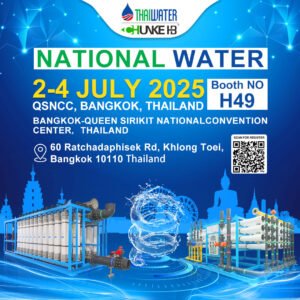We introduce Containerized Water Treatment Plant to get clean and safe water for your business. First, water treatment is a crucial process that ensures the availability of clean and safe drinking water. As industrial facilities and municipalities seek efficient and cost-effective solutions, containerized water treatment plants have emerged as a popular choice. So, these plants offer numerous advantages, including quick installation, mobility, and compact footprints. In this article, we will explore the concept of containerized water treatment plants, their applications, benefits, and considerations for implementation.
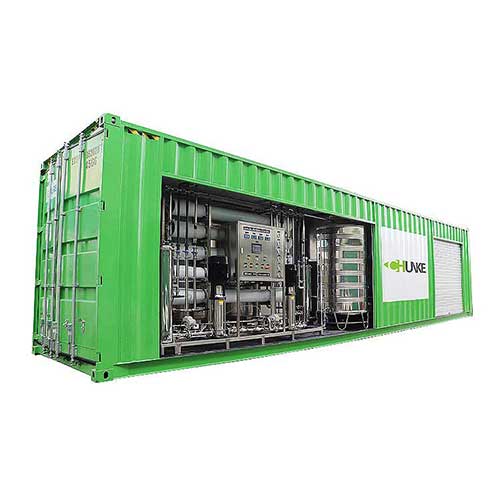
What is a Containerized Water Treatment Plant?
A containerized water treatment plant, also known as a mobile water treatment system, is a self-contained unit that houses all the necessary components for water purification. So, these systems are pre-engineered and assembled in a controlled environment, allowing for efficient and standardized production. Meanwhile, the container, typically a standard shipping container, serves as the enclosure for the entire water treatment process.
Components of a Containerized Water Treatment Plant
A containerized water treatment plant includes various components that work together to ensure effective water purification. So, these components may vary depending on the specific requirements of the application, but some common elements include:
Instrumentation Wiring:
Cabling and wiring of instrumentation inside the container are essential for monitoring and controlling the water treatment process. So, this wiring connects the instruments to the main control cabinet.
Pre-Treatment:
In containerized water treatment plant, depends on water source and quality we can use different type of pre-treatment method. Mostly, we are using chemical dosing. sand filtration, iron removal filtration, water softener, cartridge filter housing, bag filter housing, self cleaning disk filters.
Membrane Filtration:
After we check your water analysis report, our experienced engineering team decide to use which membrane filtration method is fix to your application. We can use RO membrane, Ultrafiltration membrane or Nano filtration membrane, accordingly. CHUNKE provides most economic reverse osmosis system, ultrafiltration system, nanofiltration system for containerized water treatment plant.
Membrane filtration has membrane housing, semi-permeable membrane, high pressure pump, booster pump, flow meters, pressure switches, valves, chemical dosing systems, pressure gauges.
Water Storage Tanks
Some containerized water treatment plant projects, customer wants to keep raw water and pure water storage tanks in container. We also can design all system as regards to customer demand.
Operation and Maintenance Manuals:
Proper documentation is provided in the form of operation and maintenance manuals. So, these guidelines assist operators in understanding the functioning of the plant and carrying out routine maintenance tasks.
CAD Drawings:
General Arrangement 3D/2D CAD drawings provide a visual representation of the containerized water treatment plant. So, these drawings help in understanding the layout and design of the system.
CHUNKE Containerized Water Treatment Plant Projects
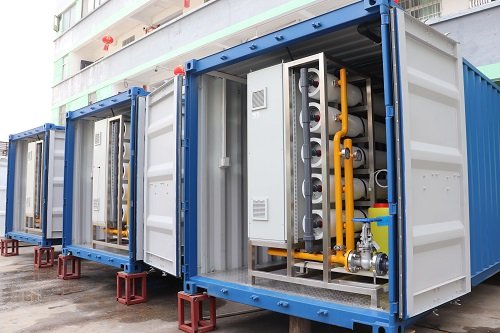
10.000lPH Sea Water Desalination SWRO
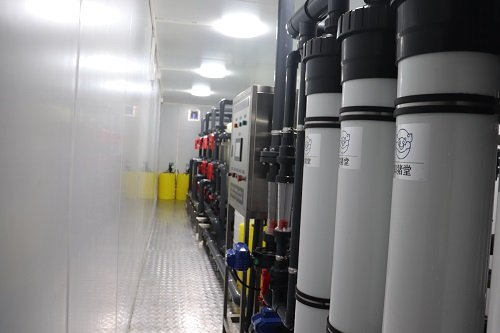
20.000LPH Ultrafiltration Water Treatment Plant
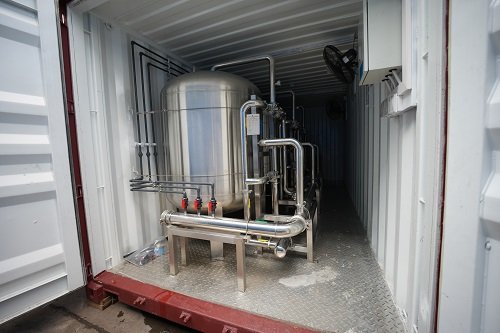
20.000LPH Containerized Water Filtration Plant
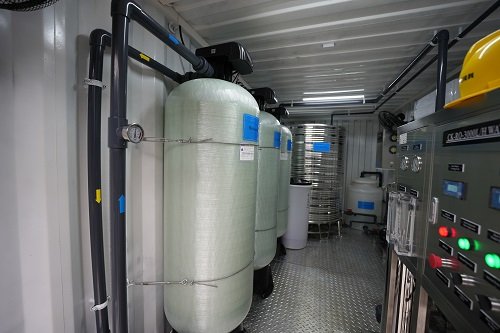
3000LPH Containerized Brackish Water Plant BWRO
Temperature Considerations for Containerized Water Treatment Plants
The temperature inside a containerized water treatment plant can significantly impact its performance. In hot climate areas, it is crucial to keep the temperature below 35ºC to ensure optimal process efficiency. Hence, direct exposure to sunlight can cause the temperature inside the container to rise to as high as 80ºC. To mitigate this, containerized plants are often equipped with air-cooled insulation and external coatings that reject sunlight.
In cold climate areas, maintaining the temperature above freezing points is essential. So, electrical equipment is particularly susceptible to damage at temperatures below 5ºC. To address this issue, insulated containers with heating equipment are used to ensure the smooth operation of the water treatment plant.
Applications of Containerized Water Treatment Systems
Containerized water treatment systems find applications in various industries and settings. Hence, their versatility and mobility make them suitable for a wide range of scenarios. Here are some industries that commonly employ containerized water treatment systems:
Construction Sites:
Containerized water treatment systems are highly convenient for construction sites. They can be easily transported and installed, providing on-site access to clean water for workers, accordingly.
Remote Locations:
In remote areas where access to clean water is limited, containerized water treatment systems offer a practical solution. These systems can be deployed quickly to provide safe drinking water to communities or temporary settlements.
Disaster Response:
During emergency situations such as natural disasters or humanitarian crises, containerized water treatment systems play a crucial role in providing immediate access to clean water. These systems can be rapidly deployed to affected areas to ensure the well-being of affected populations.
Industrial Facilities:
Industries such as power plants, oil refineries, and manufacturing facilities often require on-site water treatment. So, containerized water treatment plant offers a compact and efficient solution for these industries, ensuring compliance with regulatory standards and minimizing the impact on the environment.
Benefits of Containerized Water Treatment Systems
Containerized water treatment systems offer several advantages over traditional built-in plant installations. These benefits make them an attractive choice for various applications. Let’s explore some of the key advantages of containerized water treatment systems:
1. Short Installation Process
Containerized water treatment systems are pre-engineered and assembled off-site, significantly reducing installation time. This allows for quick deployment and faster access to clean water.
2. Compact Footprints
The compact design of containerized water treatment plant makes them ideal for applications with limited space. These systems can be easily installed in areas where traditional water treatment plants may not be feasible.
3. Simple Transportation
Containerized water treatment systems are designed for easy transportation. They can be shipped to different locations, making them suitable for temporary or mobile water treatment needs.
4. Mobility
The mobility of containerized water treatment systems enables them to be easily relocated as per changing requirements. This flexibility is particularly valuable in construction sites or remote areas where water treatment needs may vary.
5. Cost-Effective
Containerized water treatment plant offers cost savings compared to building a traditional water treatment plant. The streamlined production process and reduced on-site construction requirements contribute to overall cost efficiency.
Design and Customization of Containerized Water Treatment Plants
Containerized water treatment plants can be customized to meet specific project requirements. The design and construction of these systems are tailored to address the unique needs of each application. Here are some design considerations for containerized water treatment plants:
Container Selection:
Containers used for water treatment plants can vary in size and construction material. The most common containers are ISO shipping containers, which are readily available, cost-effective, and rugged. Alternatively, fabricated steel enclosures offer more customization options but come at a higher cost.
Site-Specific Modifications:
Containerized systems can be modified to accommodate site-specific requirements. These modifications may include adding doors, windows, access hatches, connection gland plates, and other features to ensure easy access and integration with existing infrastructure.
Treatment Technologies:
Containerized water treatment plant can incorporate various treatment technologies based on the specific water quality and treatment objectives. Common technologies include reverse osmosis (RO), nanofiltration (NF), ultrafiltration (UF), chemical feed, and pumping systems.
Safety and Compliance:
Safety measures, such as chemical storage and containment, chemically resistant coatings, safety showers, and hazardous location rated electrical equipment, can be incorporated into the design of containerized water treatment plants to ensure compliance with safety standards.
Installation and Maintenance of Containerized Water Treatment Systems
One of the significant advantages of containerized water treatment systems is their simplified installation process. These systems arrive fully assembled, with interconnecting piping, wiring, and testing completed beforehand. The installation typically involves setting the container on a sufficiently rated foundation, connecting the piping, and performing electrical terminations.
Maintenance of containerized water treatment plant requires careful consideration due to the limited space within the container. Routine maintenance activities, such as sensor calibration and filter replacement, can be carried out with proper equipment routing. However, more complex tasks, such as RO membrane replacement or pump and motor repairs, may pose challenges due to space constraints. Increasing the number of containers can alleviate some of these challenges but may also increase the overall cost.
Total Cost of Ownership and Long-Term Operations
While containerized water treatment systems offer initial cost savings and faster installation timelines, it is essential to consider the total cost of ownership and long-term operations. Customizations and additional features can increase the overall cost of a containerized system, potentially exceeding the cost of a traditional building installation. Factors such as maintenance requirements, equipment accessibility, and compliance with specific regulations should be carefully evaluated to ensure the long-term viability of a containerized water treatment system.
Conclusion
Containerized water treatment plants provide a comprehensive and efficient solution for a wide range of water treatment needs. With their compact design, quick installation process, and mobility, these systems offer numerous advantages over traditional built-in plant installations. However, it is crucial to consider factors such as customization, maintenance requirements, and long-term operations when opting for a containerized water treatment system. By carefully evaluating project needs and expectations, industries and municipalities can determine whether a containerized solution is the best fit for their water treatment requirements. Containerized water treatment plant has revolutionized the way we approach water treatment, ensuring access to clean and safe drinking water regardless of location or environmental conditions.

